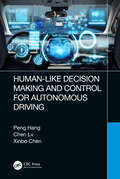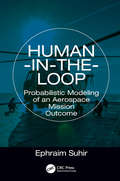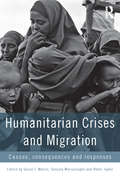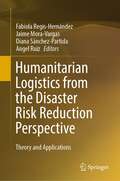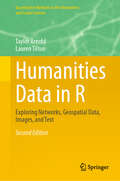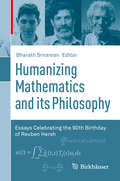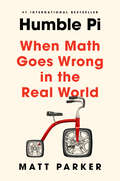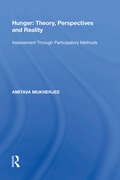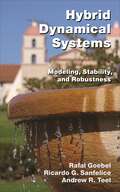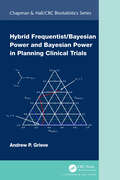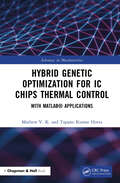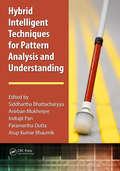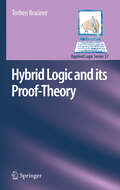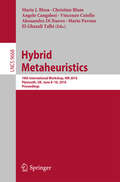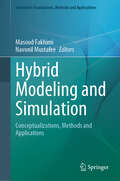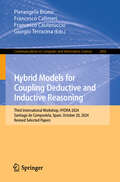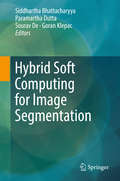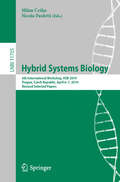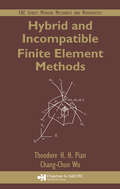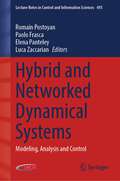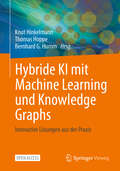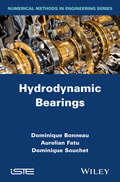- Table View
- List View
Human-Like Decision Making and Control for Autonomous Driving
by Chen Lv Peng Hang Xinbo ChenThis book details cutting-edge research into human-like driving technology, utilising game theory to better suit a human and machine hybrid driving environment. Covering feature identification and modelling of human driving behaviours, the book explains how to design an algorithm for decision making and control of autonomous vehicles in complex scenarios. Beginning with a review of current research in the field, the book uses this as a springboard from which to present a new theory of human-like driving framework for autonomous vehicles. Chapters cover system models of decision making and control, driving safety, riding comfort and travel efficiency. Throughout the book, game theory is applied to human-like decision making, enabling the autonomous vehicle and the human driver interaction to be modelled using noncooperative game theory approach. It also uses game theory to model collaborative decision making between connected autonomous vehicles. This framework enables human-like decision making and control of autonomous vehicles, which leads to safer and more efficient driving in complicated traffic scenarios. The book will be of interest to students and professionals alike, in the field of automotive engineering, computer engineering and control engineering.
Human-in-the-Loop: Probabilistic Modeling of an Aerospace Mission Outcome
by Ephraim SuhirImprovements in safety in the air and in space can be achieved through better ergonomics, better work environments, and other efforts of traditional avionic psychology that directly affect human behaviors and performance. Not limited to just the aerospace field, this book discusses adaptive probabilistic predictive modeling in human-in-the-loop situations and gets you familiar with a new, powerful, flexible, and effective approach to making outcomes from missions successful and safe. Covers the concepts, which are adaptable across other disciplines, and methodology for evaluating the likelihood of a successful outcome of an extraordinary situation Considers human performance and equipment/instrumentation reliability, as well as other possible sources of uncertainty Presents probabilistic assessment of an aerospace mission outcome Provides the most effective, physically meaningful, and cost-effective planning of an aerospace mission Offers how to organize and provide the most effective training of personnel
Humanitarian Crises and Migration: Causes, Consequences and Responses
by Susan F. Martin, Sanjula Weerasinghe and Abbie TaylorWhether it is the stranding of tens of thousands of migrant workers at the Libyan–Tunisian border, or the large-scale displacement triggered by floods in Pakistan and Colombia, hardly a week goes by in which humanitarian crises have not precipitated human movement. While some people move internally, others internationally, some temporarily and others permanently, there are also those who become "trapped" in place, unable to move to greater safety. Responses to these "crisis migrations" are varied and inadequate. Only a fraction of "crisis migrants" are protected by existing international, regional or national law. Even where law exists, practice does not necessarily guarantee safety and security for those who are forced to move or remain trapped. Improvements are desperately needed to ensure more consistent and effective responses. This timely book brings together leading experts from multi-disciplinary backgrounds to reflect on diverse humanitarian crises and to shed light on a series of exploratory questions: In what ways do people move in the face of crisis situations? Why do some people move, while others do not? Where do people move? When do people move, and for how long? What are the challenges and opportunities in providing protection to crisis migrants? How might we formulate appropriate responses and sustainable solutions, and upon what factors should these depend? This volume is divided into four parts, with an introductory section outlining the parameters of "crisis migration," conceptualizing the term and evaluating its utility. This section also explores the legal, policy and institutional architecture upon which current responses are based. Part II presents a diverse set of case studies, from the earthquake in Haiti and the widespread violence in Mexico, to the ongoing exodus from Somalia, and environmental degradation in Alaska and the Carteret Islands, among others. Part III focuses on populations that may be at particular risk, including non-citizens, migrants at sea, those displaced to urban areas, and trapped populations. The concluding section maps the global governance of crisis migration and highlights gaps in current provisions for crisis-related movement across multiple levels. This valuable book brings together previously diffuse research and policy issues under the analytical umbrella of "crisis migration." It lays the foundations for assessing and addressing real challenges to the status quo, and will be of interest to scholars, policy makers, and practitioners committed to seeking out improved responses and ensuring the dignity and safety of millions who move in the context of humanitarian crises.
Humanitarian Logistics from the Disaster Risk Reduction Perspective: Theory and Applications
by Angel Ruiz Diana Sánchez-Partida Fabiola Regis-Hernández Jaime Mora-VargasThis book aims to clarify the priorities of the Sendai Framework for the DRR 2015 – 2030, through gathering recent contributions addressing the different ways researchers define, measure, reduce, and manage risk in the challenge of the DRR. Beyond a discussion of the different definitions of disaster risk; this book provides contributions focused on optimization approaches that support the decision-making process in the challenge of managing DRR problems considering emerging disaster risks in the medium and long term, as well as national and local applications. Some of the topics covered include network flow problems, stochastic optimization, discrete optimization, multi-objective programming, approximation techniques, and heuristic approaches.The target audience of the book includes professionals who work in Linear Programming, Logistics, Optimization (Mathematical, Robust, Stochastic), Management Science, Mathematical Programming, Networks, Scheduling, Simulation, Supply Chain Management, Sustainability, and similar areas. It can be useful for researchers, academics, graduate students, and anyone else doing research in the field
Humanities Data in R: Exploring Networks, Geospatial Data, Images, and Text (Quantitative Methods in the Humanities and Social Sciences)
by Taylor Arnold Lauren TiltonThis book teaches readers to integrate data analysis techniques into humanities research practices using the R programming language. Methods for general-purpose visualization and analysis are introduced first, followed by domain-specific techniques for working with networks, text, geospatial data, temporal data, and images. The book is designed to be a bridge between quantitative and qualitative methods, individual and collaborative work, and the humanities and social sciences. The second edition of the text is a significant revision, with almost every aspect of the text rewritten in some way. The most notable difference is the incorporation of new R packages such as ggplot2 and dplyr that center broad data-science concepts. This 2nd edition of Humanities Data with R does not presuppose background programming experience. Early chapters take readers from R set-up to exploratory data analysis, with one chapter dedicated to each stage of the data-science pipeline (data collection, visualization, manipulation, and relational joins). Following this, text analysis, networks, temporal data, geospatial data, and image analysis each have a dedicated chapter. These are grounded in examples to move readers beyond the intimidation of adding new tools to their research. The final section of the book extends the core material with additional computer science techniques for processing large datasets. Everything is hands-on: image analysis is explained using digitized photographs from the 1930s, and networks are applied to page links on Wikipedia. After working through these examples with the provided data, code and book website, readers are prepared to apply new methods to their own work. The open source R programming language, with its myriad packages and popularity within the sciences and social sciences, is particularly well-suited to working with humanities data. R packages are also highlighted in an appendix. The methodology will have wide application in classrooms and self-study for the humanities, but also for use in linguistics, anthropology, and political science. Outside the classroom, this intersection of humanities and computing is particularly relevant for research and new modes of dissemination across archives, museums and libraries.
Humanizing Mathematics and its Philosophy
by Bharath SriramanThis Festschrift contains numerous colorful and eclectic essays from well-known mathematicians, philosophers, logicians, and linguists celebrating the 90th birthday of Reuben Hersh. The essays offer, in part, attempts to answer the following questions set forth by Reuben himself as a focus for this volume: Can practicing mathematicians, as such, contribute anything to the philosophy of math? Can or should philosophers of math, as such, say anything to practicing mathematicians? Twenty or fifty years from now, what will be similar, and what will, or could, or should be altogether different: About the philosophy of math? About math education? About math research institutions? About data processing and scientific computing? The essays also offer glimpses into Reuben's fertile mind and his lasting influence on the mathematical community, as well as revealing the diverse roots, obstacles and philosophical dispositions that characterize the working lives of mathematicians. With contributions from a veritable "who's who" list of 20th century luminaries from mathematics and philosophy, as well as from Reuben himself, this volume will appeal to a wide variety of readers from curious undergraduates to prominent mathematicians.
Humble Pi: When Math Goes Wrong in the Real World
by Matt ParkerAn international bestsellerThe book-length answer to anyone who ever put their hand up in math class and asked, &“When am I ever going to use this in the real world?&” &“Fun, informative, and relentlessly entertaining, Humble Pi is a charming and very readable guide to some of humanity's all-time greatest miscalculations—that also gives you permission to feel a little better about some of your own mistakes.&” —Ryan North, author of How to Invent Everything Our whole world is built on math, from the code running a website to the equations enabling the design of skyscrapers and bridges. Most of the time this math works quietly behind the scenes . . . until it doesn&’t. All sorts of seemingly innocuous mathematical mistakes can have significant consequences. Math is easy to ignore until a misplaced decimal point upends the stock market, a unit conversion error causes a plane to crash, or someone divides by zero and stalls a battleship in the middle of the ocean. Exploring and explaining a litany of glitches, near misses, and mathematical mishaps involving the internet, big data, elections, street signs, lotteries, the Roman Empire, and an Olympic team, Matt Parker uncovers the bizarre ways math trips us up, and what this reveals about its essential place in our world. Getting it wrong has never been more fun.
Hunger: Assessment Through Participatory Methods (King's Soas Studies In Development Geography)
by Amitava MukherjeeHunger is an issue which has been subject to much rigorous intellectual examination by economists, philosophers, sociologists, NGOs and governments. This volume provides a critical overview of current academic and political perspectives and then compares these views from thenon-hungry people with those of thehungry particularly from a broad range of poor communities in India. Their views are gathered using participatory rural appraisal techniques and the scale of the material presented is unprecedented. Not surprisingly, the comparisons show that the perceptions of the hungry are fundamentally different from those of the non-hungry. It makes compelling suggestions about how best policy makers can attempt to eliminate hunger based on what the hungry themselves suggest. The book also draws attention to the critical role of Common Property Resources and women in the fight against under-nutrition, which have so far been largely ignored.
Hunters Money Jar
by Charlotte GuillainA coin named Scratch lives with her friends in Hunter's money jar. The bills and coins know that Hunter is saving up for a skateboard, but there aren't enough of them yet. Join Scratch as she welcomes new friends to the jar. Together, can they help Hunter get that new skateboard?
Husker Numbers: A Nebraska Number Book
by Rajean Luebs ShepherdIn Husker Numbers: A Nebraska Number Book, readers can step back in history and experience nineteenth century frontier army life at Fort Atkinson, count the many ancient petroglyphs at Indian Cave State Park, or even 'regain' their marbles at Lee's Legendary Marbles museum in York. From the majestic natural landmark of Chimney Rock (a National Historic Site) to the 900,000 gallons of salt water in the Shark Tunnel at Henry Doorly Zoo, Nebraska has 'countless' treasures for all to enjoy.
Hybrid Dynamical Systems: Modeling, Stability, and Robustness
by Andrew R. Teel Rafal Goebel Ricardo G. SanfeliceHybrid dynamical systems exhibit continuous and instantaneous changes, having features of continuous-time and discrete-time dynamical systems. Filled with a wealth of examples to illustrate concepts, this book presents a complete theory of robust asymptotic stability for hybrid dynamical systems that is applicable to the design of hybrid control algorithms--algorithms that feature logic, timers, or combinations of digital and analog components. With the tools of modern mathematical analysis, Hybrid Dynamical Systems unifies and generalizes earlier developments in continuous-time and discrete-time nonlinear systems. It presents hybrid system versions of the necessary and sufficient Lyapunov conditions for asymptotic stability, invariance principles, and approximation techniques, and examines the robustness of asymptotic stability, motivated by the goal of designing robust hybrid control algorithms. This self-contained and classroom-tested book requires standard background in mathematical analysis and differential equations or nonlinear systems. It will interest graduate students in engineering as well as students and researchers in control, computer science, and mathematics.
Hybrid Frequentist/Bayesian Power and Bayesian Power in Planning Clinical Trials (Chapman & Hall/CRC Biostatistics Series)
by Andrew P. GrieveHybrid Frequentist/Bayesian Power and Bayesian Power in Planning Clinical Trials provides a practical introduction to unconditional approaches to planning randomised clinical trials, particularly aimed at drug development in the pharmaceutical industry. This book is aimed at providing guidance to practitioners in using average power, assurance and related concepts. This book brings together recent research and sets them in a consistent framework and provides a fresh insight into how such methods can be used.Features: A focus on normal theory linking average power, expected power, predictive power, assurance, conditional Bayesian power and Bayesian power. Extensions of the concepts to binomial, and time-to-event outcomes and non-inferiority trials An investigation into the upper bound on average power, assurance and Bayesian power based on the prior probability of a positive treatment effect Application of assurance to a series of trials in a development program and an introduction of the assurance of an individual trial conditional on the positive outcome of an earlier trial in the program, or to the successful outcome of an interim analysis Prior distribution of power and sample size Extension of the basic approach to proof-of-concept trials with dual success criteria Investigation of the connection between conditional and predictive power at an interim analysis and power and assurance Introduction of the idea of surety in sample sizing of clinical trials based on the width of the confidence intervals for the treatment effect, and an unconditional version.
Hybrid Genetic Optimization for IC Chips Thermal Control: With MATLAB® Applications (Advances in Metaheuristics)
by Mathew V. K. Tapano Kumar HottaThe continuous miniaturization of integrated circuit (IC) chips and the increase in the sleekness of the design of electronic components have led to the monumental rise of volumetric heat generation in electronic components. Hybrid Genetic Optimization for IC Chips Thermal Control: With MATLAB® Applications focuses on the detailed optimization strategy carried out to enhance the performance (temperature control) of the IC chips oriented at different positions on a switch-mode power supply (SMPS) board and cooled using air under various heat transfer modes. Seven asymmetric protruding IC chips mounted at different positions on an SMPS board are considered in the present study that is supplied with non-uniform heat fluxes. Key Features: Provides guidance on performance enhancement and reliability of IC chips Provides a detailed hybrid optimization strategy for the optimal arrangement of IC chips on a board The MATLAB program for the hybrid optimization strategy along with its stability analysis is carried out in a detailed manner Enables thermal design engineers to identify the positioning of IC chips on the board to increase their reliability and working cycle
Hybrid Intelligent Techniques for Pattern Analysis and Understanding
by Siddhartha Bhattacharyya Paramartha Dutta Anirban Mukherjee Indrajit Pan Arup Kumar BhaumikHybrid Intelligent Techniques for Pattern Analysis and Understanding outlines the latest research on the development and application of synergistic approaches to pattern analysis in real-world scenarios. An invaluable resource for lecturers, researchers, and graduates students in computer science and engineering, this book covers a diverse range of hybrid intelligent techniques, including image segmentation, character recognition, human behavioral analysis, hyperspectral data processing, and medical image analysis.
Hybrid Logic and its Proof-Theory
by Torben BraünerThis is the first book-length treatment of hybrid logic and its proof-theory. Hybrid logic is an extension of ordinary modal logic which allows explicit reference to individual points in a model (where the points represent times, possible worlds, states in a computer, or something else). This is useful for many applications, for example when reasoning about time one often wants to formulate a series of statements about what happens at specific times. There is little consensus about proof-theory for ordinary modal logic. Many modal-logical proof systems lack important properties and the relationships between proof systems for different modal logics are often unclear. In the present book we demonstrate that hybrid-logical proof-theory remedies these deficiencies by giving a spectrum of well-behaved proof systems (natural deduction, Gentzen, tableau, and axiom systems) for a spectrum of different hybrid logics (propositional, first-order, intensional first-order, and intuitionistic).
Hybrid Metaheuristics
by Angelo Cangelosi Christian Blum Maria J. Blesa Vincenzo Cutello Alessandro Di Nuovo Mario Pavone El-Ghazali TalbiThis book constitutes the refereed proceedings of the 10th International Workshop on Hybrid Metaheuristics, HM 2016, held in Plymouth, UK, in June 2016. The 15 revised full papers presented were carefully reviewed and selected from 43 submissions. The selected papers are of interest for all the researchers working on integrating metaheuristics with other areas for solving both optimization and constraint satisfaction problems. They represent as well a sample of current research demonstrating how metaheuristics can be integrated with integer linear programming and other operational research techniques for tackling difficult and relevant problems.
Hybrid Modeling and Simulation: Conceptualizations, Methods and Applications (Simulation Foundations, Methods and Applications)
by Navonil Mustafee Masoud FakhimiThe unique book advances understanding of modelling complex systems using hybrid approaches that combine discrete-event, agent-based, and system dynamic simulations with research approaches and artefacts from other scientific disciplines. As systems become increasingly large and complex, it is a challenge to capture the intricacies of the underlying system and offer novel forms of analysis using only models that employ a single simulation technique. The book underscores the importance of both hybrid simulation (employing techniques primarily developed in the field of modelling and simulation) and hybrid modelling (incorporating simulation with methods from wider disciplines such as applied computing, data science, engineering, and soft/qualitative operations research). Furthermore, the text aims to inspire further research and practice, fostering the growth of cross-disciplinary hybrid models. Topics and features: Provides a comprehensive overview of hybrid modelling and simulation, including methodological extensions and novel applications Features case studies and examples demonstrating the synergy realized by applying hybrid methods Calls for innovation and growth of the discipline by incorporating diverse scientific perspectives Encourages adoption of interdisciplinary methods to engender improved insights from simulation studies Promotes interdisciplinary collaboration, pushing modelling and simulation into new research and application areas This comprehensive volume will appeal to researchers, academics, students, and practitioners who seek to advance their modelling and simulation work. The book also will serve as a reference, informing research communities of the potential of hybrid models that combine simulation with disciplinary research artefacts, methods, and approaches.
Hybrid Models for Coupling Deductive and Inductive Reasoning: Third International Workshop, HYDRA 2024, Santiago de Compostela, Spain, October 20, 2024, Revised Selected Papers (Communications in Computer and Information Science #2492)
by Francesco Calimeri Giorgio Terracina Pierangela Bruno Francesco CauteruccioThis book constitutes the refereed proceedings of the Third International Workshop on Hybrid Models for Coupling Deductive and Inductive Reasoning, HYDRA 2024, held in Santiago de Compostela, Spain, on October 20, 2024. The 6 full papers and 1 invited talk included in this book were carefully reviewed and selected from 7 submissions.The International Workshop on Hybrid Models for Coupling Deductive andInductive Reasoning (HYDRA) was designed as a forum for researchers to explore the exciting possibilities at the intersection of deductive and inductive reasoning.
Hybrid Optimization: The Ten Years of CPAIOR (Springer Optimization and Its Applications #45)
by Pascal Van Hentenryck Michela MilanoHybrid Optimization focuses on the application of artificial intelligence and operations research techniques to constraint programming for solving combinatorial optimization problems. This book covers the most relevant topics investigated in the last ten years by leading experts in the field, and speculates about future directions for research. This book includes contributions by experts from different but related areas of research including constraint programming, decision theory, operations research, SAT, artificial intelligence, as well as others. These diverse perspectives are actively combined and contrasted in order to evaluate their relative advantages. This volume presents techniques for hybrid modeling, integrated solving strategies including global constraints, decomposition techniques, use of relaxations, and search strategies including tree search local search and metaheuristics. Various applications of the techniques presented as well as supplementary computational tools are also discussed.
Hybrid Soft Computing for Image Segmentation
by Siddhartha Bhattacharyya Paramartha Dutta Sourav De Goran KlepacThis book proposes soft computing techniques for segmenting real-life images in applications such as image processing, image mining, video surveillance, and intelligent transportation systems. The book suggests hybrids deriving from three main approaches: fuzzy systems, primarily used for handling real-life problems that involve uncertainty; artificial neural networks, usually applied for machine cognition, learning, and recognition; and evolutionary computation, mainly used for search, exploration, efficient exploitation of contextual information, and optimization. The contributed chapters discuss both the strengths and the weaknesses of the approaches, and the book will be valuable for researchers and graduate students in the domains of image processing and computational intelligence.
Hybrid Systems Biology: 6th International Workshop, HSB 2019, Prague, Czech Republic, April 6-7, 2019, Revised Selected Papers (Lecture Notes in Computer Science #11705)
by Nicola Paoletti Milan ČeškaThis book constitutes the thoroughly refereed proceedings of the 6th International Workshop on Hybrid Systems Biology, HSB 2019, held in Prague, Czech Republic, in April 2019.The 8 full papers presented in this book together with 1 short paper and 3 invited papers were carefully reviewed and selected from 13 submissions. They cover topics such as: modeling and analysis of metabolic, signaling, and genetic regulatory networks in living cells; models of tissues, organs, physiological models; models and methods coping with incomplete, uncertain and heterogeneous information including learning for biological systems, parametric synthesis and inference; stochastic and hybrid models in biology; hierarchical systems for multi-scale, multi-domain analysis; abstraction, approximation, discretization, and model reduction techniques; modeling, analysis and design for synthetic biology, cyber-biological systems and biomedical studies (e.g. therapies, teleoperation); game-theoretical frameworks and population models in biology (e.g. mixed-effects and Bayesian modeling); biological applications of quantitative and formal analysis techniques (e.g. reachability computation, model checking, abstract interpretation, bifurcation theory, stability and sensitivity analysis); efficient techniques for combined and heterogeneous (stochastic/deterministic, spatial/non-spatial) simulations for biological models; modeling languages and logics for biological systems with related analysis and simulation tools; and control architectures of biological systems including biology-in-the-loop systems and bio-robotics.
Hybrid and Incompatible Finite Element Methods (Modern Mechanics and Mathematics)
by Theodore H.H. Pian Chang-Chun WuWhile the theory and application of finite elements methods can be extended to incompatible, hybrid, and mixed element methods, important issues, such as determining the reliability of the solution of incompatible multivariable elements, along with a common perception of impracticality, have hindered the widespread implementation of these methods.
Hybrid and Networked Dynamical Systems: Modeling, Analysis and Control (Lecture Notes in Control and Information Sciences #493)
by Luca Zaccarian Elena Panteley Paolo Frasca Romain PostoyanHybrid and Networked Dynamical Systems treats a class of systems that is ubiquitous in everyday life. From energy grids to fleets of robots or vehicles to social networks to biological networks, the same scenario arises: dynamical units interact locally through a connection graph to achieve a global task. The book shows how analysis and design tools can be adapted for control applications that combine the effects of network-induced interactions and hybrid dynamics with complex results.Following a scene-setting introduction, the remaining 12 chapters of the book are divided into three parts and provide a unique opportunity to describe the big picture that is the culmination of years of recent research activity. The contributing authors expand on their ideas at greater length than is possible in an archival research paper and use in-depth examples to illustrate their theoretical work.The widespread importance of hybrid and networked systems means that the book is of significant interest to academic researchers working in applied mathematics, control, and electrical, mechanical and chemical engineering and to their industrial counterparts.
Hybride KI mit Machine Learning und Knowledge Graphs: Innovative Lösungen aus der Praxis
by Thomas Hoppe Knut Hinkelmann Bernhard G. HummSeit den 2010er Jahren hat die Künstliche Intelligenz (KI) durch Erfolge im Machine Learning (ML) einen enormen Schub erfahren. Einerseits durch die stark angewachsene Menge verfügbarer digitaler Daten und andererseits durch Innovationen im Bereich der Künstlichen Neuronalen Netze und des Deep Learning (DL). Wissensbasierte KI umfasst neben traditionellen Expertensystemen und Regelsystemen auch die Technologien und Standards, welche im Rahmen der Semantic Web Initiative seit den 1990er Jahren entwickelt wurden. Sie ermöglichten unter anderem die Entwicklung umfangreicher Knowledge Graphs (Wissensnetze). Hybride KI Ansätze kombinieren Machine Learning und wissensbasierte KI. Da sie als erfolgversprechend gelten, werden sie seit Jahren erforscht. Dieser Sammelband zeigt, wie innovative hybride KI-Verfahren bereits heute erfolgreich in der Praxis eingesetzt werden. Dies ist ein Open Access-Buch.
Hydrodynamic Bearings
by Dominique Bonneau Aurelian Fatu Dominique SouchetThis Series provides the necessary elements to the development and validation of numerical prediction models for hydrodynamic bearings. This book describes the rheological models and the equations of lubrication. It also presents the numerical approaches used to solve the above equations by finite differences, finite volumes and finite elements methods.
